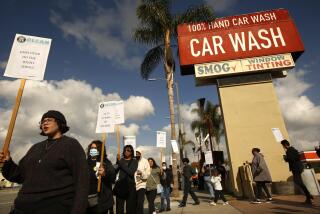Corporate power increases as workers battle one another
Of the social developments of recent decades, certainly one of the most perplexing is the revolt of the working class against workers.
Last week’s election results only scratch the surface of a trend that destroys social cohesion and makes it harder for businesses — small and large — to prosper. Voters in San Jose and San Diego opted to cut public employee pension programs; on the national stage, Wisconsin’s openly anti-labor governor, Scott Walker, handily turned away a recall campaign inspired by his effort to kill collective bargaining rights for public workers.
None of the votes appears to be purely anti-labor. The California polls were expressions of municipal fiscal anxiety, aimed at one of the few lines of a local budget (payroll) that may yet be under voters’ control. Walker apparently prevailed in part because Wisconsinites (unlike Californians) don’t cotton to recalling governors just like that, and also because wealthy industrialists backing Walker outspent unions and Democratic contributors backing his opponent by about 7 to 1.
But the results are a good starting point for a survey of the working- and middle-class landscape in America. It’s important to examine the balance of power between corporations and workers now, and not merely because big money from either side is going to be oozing from candidates’ pores in this electoral season. But labor’s diminishing power has much to do with the weakness of the economic recovery and the bloodlessness of consumer demand. Put simply, when more and more of the bounty of economic growth flows to those who don’t need to spend it, and so little to those who immediately would crank it into the retail economy, demand will continue to stagnate. That means meager job growth.
Worse, as workers battle one another for smaller slices of the same shrinking pie, they see others in the same fix not as neighbors but rivals. Today’s vision of the working-class economy as a zero-sum game underlies public opposition to all sorts of stimulative programs — assistance for strapped homeowners, to cite one example.
Requiring lenders to rewrite underwater mortgages by forgiving excess principal rather than forcing them into foreclosure would be beneficial for homeowners, their neighbors, their lenders and their local merchants alike. But voters terrified about slippage in their own standard of living greet with resentment the prospect of someone else getting a hand. There’s no point in condemning this reaction as selfish or shortsighted. It’s human nature, and it has never been exploited by the powers that be as effectively as it is today.
Surely it’s no secret that the steady increase in wealth and income inequality in the U.S. has coincided with the evaporation of worker power and the decline of unionization, which fell below 7% among private-sector workers last year. In 1955, the ratio was 33%. That surely contributes to the anti-labor tone of so much legislative activity across the country and in Washington, where the House of Representatives has mounted a full-scale assault on the National Labor Relations Board.
The problem confronting the U.S. is where to find a counterweight to “pro-business” government policies that tend to steer the distribution of wealth and income toward the highest strata of society instead of distributing the fruits of economic growth broadly — and fairly.
Among the obstacles to the creation of effective economic policy is the myth that corporations and unions are two sides of the same coin. Unions back Democrats, corporations back Republicans, but other than that they’re functionally equivalent, exact counterweights to each other’s political influence. This was supposedly the saving grace of the Supreme Court’s infamous 2010 Citizens United decision, which took the handcuffs off corporate spending on political campaigns, and off union spending too.
One would think the absurdity of this equivalence to be self-evident, but here are a few signposts. Corporations collect their revenues from customers; unions get theirs from their members. But corporations don’t necessarily represent the interests of their customers (or haven’t you had to deal with your cellphone company lately?); while unions consistently represent the interests of their membership.
You won’t generally find a union supporting a political candidate whose platform calls for suppressing the right to collective bargaining; but it’s standard operating procedure for, say, cable companies to support candidates who favor giving them more freedom to stick their customers with bigger bills.
One common trope is that both corporations and unions are governed by democracy. Shareholders get a vote, dues-paying union members get a vote, what’s the diff?
The difference is that “shareholder democracy” is a joke: An anti-management shareholder campaign winning a majority vote at the annual meeting is man-bites-dog news. The increasingly prevalent democratic style in American corporations, especially in Silicon Valley, is for one shareholder or a small group to control a majority of votes (e.g. Google, Zynga, Mark Zuckerberg). Indeed, a single shareholder can control a corporation with less than 50% share ownership (hello, Rupert Murdoch).
By contrast, union elections are often close-fought affairs, with fundamental disagreements over policy and strategy at stake. None of this means that union members’ interests are always aligned with the public interest, only that leaders of a union with a million members will tend to pursue policies and support candidates serving the common interests of a million people and their families. A corporation with a million shareholders still might reflect only the interests of the two or three guys at the top.
One important question raised by a playing field tilted toward corporate interests is where to find a counterweight to increasing corporate power, if not in collective bargaining or the creation of a broad-based social and political voice. Or do we have to wait for a truly cataclysmic economic event to level the field?
It’s hard to identify an answer, but easy to pinpoint the consequences of failing to do so. The previous heyday of corporate dominance of U.S. financial and economic policymaking spanned the 1920s and ‘30s. The harvest then was the Great Depression, but even as the country struggled to recover, some government institutions still favored business as usual.
In those days the Supreme Court could with a straight face outlaw a New York minimum wage law for interfering with the implicit contract between employer and employee — even when, as in the case then at hand, the “contract” was between female laundresses and a Brooklyn laundry owner who was flagrantly defrauding them of their legal wages. FDR’s irascible Interior secretary, Harold Ickes, castigated the high court for preserving “the sacred right … of an immature child or a helpless woman to drive a bargain with a great corporation.” Even ex-President Hoover thought the justices had overreached.
One gets the sense that voters in many parts of the country would be siding against that child or woman today — it’s their fault for not having the education to get a real job, after all. In California, years of imprudent budgeting and investment policies by local and state officials have contributed mightily to their fiscal swamp, but those who will pay for its draining with their pension rights will be schoolteachers, librarians and other public workers whose average retirement benefits range from $28,000 to $36,000 a year, according to the California Public Employees’ Retirement System (many don’t qualify for Social Security either).
These people aren’t the cause of our economic or fiscal problems, they’re just the people easiest to whack. President Obama got horselaughs recently for suggesting that state and local government layoffs have been a big drag on the recovery. But 190,000 workers in those sectors have lost their jobs in the last three years. Ask your local shopkeepers, who depend on customers like them, if they think that’s funny.
Michael Hiltzik’s column appears Sundays and Wednesdays. Reach him at mhiltzik@latimes.com, read past columns at latimes.com/hiltzik, check out facebook.com/hiltzik and follow @latimeshiltzik on Twitter.







